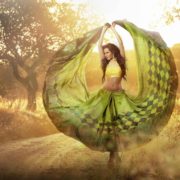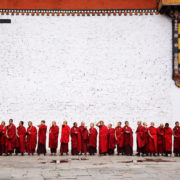Liselott Johnsson is an artist and registered architect who creates geometric paintings, sculptures and architectural installations. She obtained her Master of Architecture degree from Ecole d’Architecture de Paris-Belleville in France, and Chalmers University of Technology in Gothenburg, Sweden. She is intrigued by the formal boundaries of paintings as they relate to objects and architecture and uses material, space, color and geometry to study the qualities of these limits. Her work explores the notion that art and geometry can be constituted with abstractions.

1. We all have an inspiration in life. For you, it seems the root of your work began with witnessing your grandfather pioneer in sailboat design. How did you succeed at getting your passion for art, architecture and design together?
I can’t say how it started. As a child, I was already fascinated with art and architecture. Also, my mother had a strong interest in design and taught us children about the joy and value of well-conceived objects. She collected glasses, china, furniture, as well as paintings. There wasn’t an empty area in the house.
Of course there was an indirect influence from my grandfather, Carl Andersson, a noteworthy sailboat designer and builder, even though he passed away when I was a child. My grandfather’s sailboats were recognized in Europe for their excellent sailing ability, quality and beauty.
At school, both science and drawing were very easy for me, so architecture ended up being a good career choice. Through competition, I was accepted to the renowned architecture school at Chalmers University of Technology in Gothenburg. Searching to know more about classic and monumental architecture, I soon transferred to Ecole d’Architecture de Paris-Belleville in Paris. Following the traditional Beaux-Art training method, our classes included both architecture and art. We studied under some of the most accomplished architects and artists of the time and spent hours and days drawing at the Louvre, the Rodin Museum and at the Versailles Gardens, etc.
It was hard work and very competitive, while truly enriching. My interest in art, design and architecture has remained through my life. I actually don’t know how to separate these from my life!
2. We gathered that you are not only an artist and an architect, but an eminent writer as well. Was it only an experience or something else that helped you break and understand the works of different artists?
Contrary to design and art making, writing doesn’t come easy for me but I find it very enriching. To be able to enjoy architecture and art, one has to try to understand how and why it was made. Actually, all man-made objects carry a hidden history of development. For instance, when I look at a building and try to understand it, I want to know what the architect did differently from his/her predecessors and why.
Writing about art forces one to organize one’s thoughts and opinions into something more coherent. Writing about art allows for a thorough reading of the object of study. It also helps me make decisions in my own practice. For me, writing functions an analytical tool.

3. Space, shape and light are elements that dominate your work and seek to break through the dominant modernist paradigm. Could you tell our community what deeper meaning your work seeks to convey?
First of all, my work hovers in a space between architecture and painting; somewhere between reality and illusion. A component of my work attempts to capture what isn’t visible but what can be experienced with other senses. This can be seen in the works that deal with transparency, reflection and light.
My work also attempts to activate historically important architectural spaces so that they can be seen and experienced again. One of the most powerful tools of survival we humans possess is our ability to adapt. The negative effect of this means that we stop “seeing” what we have in front of us every day; we accept them as is unless someone points out that these spaces are of value. For instance, we could look at public washbasins found in a small French Village that are no longer used. As a result, they are no longer repaired or maintained, despite of their rich historical and cultural significance. Or it could be the space of the public libraries that occupy a very important cultural and social function that now struggle to adapt to new era of digital books.
So I use my installations to highlight and call into question architectural spaces and cultural systems that have fallen into oblivion, are in the process of change, or seem locked into a specific order for a reason that nobody cares to remember anymore.
4. Geometry is fixed, measured and shaped which is totally contrary to the formless concept of the ‘Abstract’. Your works witness a mixture of these paradoxes. How have you been able to achieve this?
I think geometry isn’t fixed and abstract isn’t formless. Today, with computer-aided design, which is based on geometry and mathematics, more complex designs and shapes can be made than ever before. Also, there are more images and more art readily available for viewing than any other time before in history. The line between abstraction and representation is no longer a big question in art. All art, even hyper-realistic paintings and photographs, are an abstraction of reality.
At the same time they have a reality and existence in their own right. My choice of using very simple shapes and, in most cases, flat color, stems from a conviction that color and geometric shapes carry messages that are very powerful. My paintings operate like signals. They don’t pretend to represent anything else than what they are: color, material, and light. But when presented in a certain way or in a certain context, very simple colors are extremely powerful conveyors of feeling and meaning.
Of course each person will understand the work in their own way.

5. Your art mostly contains bright and energetic colors. Do you have any particular aspect in mind while choosing the color of your installations? Do they point towards a positive nihilistic approach?
The color choices made for a project are very important. I spend a lot of time contemplating the palette and choosing the materials involved. I am always highly aware of the environment where the work will be displayed and the light conditions of the place.
When you display in architectural environments you have to decide if you are going to have a dialogue with the architecture and in what terms. My work is made to be experienced in person. So for instance, at the monastery, my installation of very colorful bands made the painted facades of the cloister come to life. I don’t know if a positive nihilistic approach can be translated into my color choices, but rather in my emphasis on working with real existing spaces in the present.
Contrary to most painters, I refuse to create deep spaces beyond the picture plane. I think that the space of the present moment is really what matters. I see the picture plane as a separation between here and another space beyond and I prefer a celebration of the now.
6. We would like you to inspire our aspiring artists/architects with a few words of encouragement.
If you seriously pursue a career as an architect or artist you will never have another dull moment in your life!

7. How has building a website to display your artistry helped you reach out to an audience better? Although your work speaks for itself, do you feel artists must promote themselves via popular social networking sites such as Facebook? Share with us your thoughts on experiencing Pixpa.
Today, if one works in the creative field, one has to have a presence on the web. There is no alternative to this. One effective way to reach out on social media is through an active website. I enjoy very much working on my website and updating it. It takes some time but it is very satisfying.
The website allows a person to read about my work, look at pictures and download articles without having to contact me directly. I use my website both as a record of projects I’ve done but also as an information tool.
I am very satisfied with my Pixpa-site. Right now it perfectly suits my needs.


